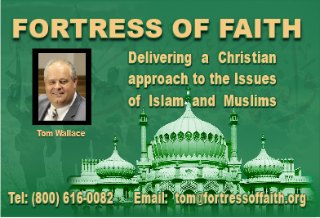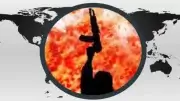 (for more indepth understanding of Islam, see Virginia Christian Alliance advisor, Dan Wolf’s 13 part series by clicking HERE) (See Part 1 Here)
(for more indepth understanding of Islam, see Virginia Christian Alliance advisor, Dan Wolf’s 13 part series by clicking HERE) (See Part 1 Here)
Fortress of Faith Radio by Tom Wallace and Shahram Hadian, and today’s program: The History of Islam. Below are simple SHOW NOTES and prone to typos. So, Listen to the program HERE ( OR DOWLOAD THE MP3 HERE)
We call Islam a religion, but historically we see it is more of a political-military movement. We see this when we study the caliphates (empires) of Islam.
Before we get into the next period, I want to go back to Muhammad’s migration to Medina. Not only did the character of Islam change at that time, there was also a change of the calendar. The Islamic calendar is not the same as ours. We are in 2016, but on the Muslim calendar it is 1438. Their calendar begins in our year 622. Our calendar uses the abbreviation AD to indicate Ano Domini, the year of our Lord. The Muslim calendar uses AH for Ano Hijra (migration), the year of the migration.
Today we are 578 years apart, but since our calendar is based on the solar year, and the Muslim calendar is based on the lunar year, the gap is closing. The lunar year is about 11 days shorter than the solar year. The calendars will agree in the year 2860.
We are not talking about religious history, we are talking about a history of conquest. We are not talking about religious leaders, we are talking about rulers and kingdoms. It is important that we understand that Muhammad was not just building a religion, he was building an empire.
The Umaayyad Caliphate (Damascus, Syria) 661 – 750 (41AH)
During this period they move the headquarters of Islam from Arabia to Damascus in Syria. Remember, before Islam conquered Syria, it was the largest Christian nation on earth. Today Syria is only about 10% Christian.
Islam expanded by conquest, and they were conquering non-Arabs. They moved into Persia (Iran), India, and North Africa.
The founder of the Umaayyad Caliphate was Abu Sufyan from Mecca. One of the desires of this caliphate was to restore a true Arabic culture within Islam. I think this is one of the hidden differences between the Sunni Muslims and th Shi’ite Muslims. I think there is a lesser than attitude that makes Arab Muslims more pure, and all other Muslims lesser.
This caliphate ran from 661 to about 750, but I believe the death blow came in 732. We will talk about this later.
When they established Damascus as the headquarters of the Islamic government, they made Arabic the official language of the government, and all of the coinage. Again, we are not talking about a religion, we’re talking about a government with its own money. The goal of this caliphate is to bring some unity by bringing it back to an Arabic Islam.
They had expanded all the way across Northern Africa. They then turned to Europe. They invaded and conquered Spain. From Spain they started to expand into France. Thank God for a leader named Charles Martel (Charles the Hammer). In 732, Martel stopped the advance of the Islamic armies. This was the beginning of driving them out of Europe. This is why I believe that the Battle of Poitiers, also called the battle of Tours, in 732 was the beginning of the end of this caliphate.
Within 100 years after Muhammad, Islam had expanded all the way into France. This never would have happened with only conversions to Islam. It only happened because of the military-governmental sword behind the expansion. All of those who are talking about the peaceful history of Islam are not looking at its true history. Islam’s history is one of bloodshed and war, leaving a wake of dead bodies in its path.
During this time we also see the versions of the Qur’an developed. They claim that they go back to the time of Muhammad, but the evidence shows that they are really of more recent origin.
The Abbasid Caliphate (Baghdad, Iraq) 750 – 1517
This caliphate moved the headquarters from Damascus to Baghdad in modern day Iraq. There was also a language change. Prior to this caliphate, Arabic was the language of the government. This seems to be lost from this point forward. The language of the government became Turkish, and this continued until the end of the Ottoman empire. Arabic has always be the language of the religion, but not always the language of the caliphate.
Under the previous caliphate they lost ground in Europe. This caliphate expanded toward the east into Iraq. It seems that this caliphate was trying to undo some of the second class status of non-Arabic Muslims.
This caliphate lasted much longer than those before it. It goes from 758 until mid 12th century. Many refer to this as the golden period of Islam. They were supposedly coexisting with Christians and Jews. We are told that it would be great if we could go back to that time. We need to remember that at this time the Christians and Jews were living as second class citizens.
In both of the last two caliphates it seems like they wanted to convert people to Islam, but it was almost like, don’t talk about it too much because, if too many are converted, they will not be paying the jizya tax. If they truly believed in the religious part of Islam, their focus would have been on conversions. Instead, they were focused on expansion of the kingdom.
There was a short break in this caliphate in 1258. It picked up again in 1261 and continued until 1517. This is the period of the Crusades. Every time the European armies went to war with the Muslims, it was to take back ground that had been taken from them by the Muslims. We also had the beginning of the Ottoman empire, and some of the Crusades were against the Turks.
The Regional Caliphates – Ottoman, Safavid, Mughal Empires
Safavid Empire
This empire started in 1501 and lasted until 1772. It is the background for Islam in modern Iran. It was predominantly the Shi’ite split, while the Ottoman Empire was more the Sunni side of things. It covered Iran, parts of eastern Turkey, Afghanistan, and Pakistan. It even spread unto central Asia. Its headquarter was Esfahan, in Iran. It is still the religious capital in Iran.
Even though this was a caliphate, it was more of a theocracy. This is where Iran is today, it is a theocracy. This is the Shi’ite form of government. It must have a theocracy with a supreme counsel
The Safavid empire controlled a lot of trade routes because of its location. It was the trade link between the east and the west.
It function parallel to the Ottoman Empire for a good part of its existence. The language of this empire was Farsi, not Arabic.
Ottoman Empire
This empire took over the Byzantine Empire. This is modern day Turkey. The Ottoman Empire conquered the Safavid Empire and expanded all the way to Arabia. It probably controlled more land than any caliphate in Islamic history.
The Ottoman Empire tried to enter Europe again from the east. The first siege was against Vienna in 1529. The final battle for Vienna was in 1683. During this period there were constant attacks on this front. The battle of 1683 was the second major defeat, remember the first was in 732, in France.
Today Islam is taking over Western Europe, not by the sword, but by migration. They are using immigration, refugees, and a high birth rate to conquer Europe.
The date of the last day of this battle is significant. It was September 11, 1683. The date 9/11, is a very significant date in Islamic history. It was not an accident that this date was used as a launching pad against the West. In America we say, Remember the Alamo, not because of a victory, but because of a defeat. The battle of Vienna was an important defeat to the Islamic world.
Another important fact about the Ottoman Empire is that, under Suleiman the Magnificent, they controlled the Mediterranean. They lost this and he went to Israel and tried to control Jerusalem. He is the one who built the walls that are there today. The later Crusades were fought at that time against the Turks.
This area of Islamic history is whitewashed in our textbooks. They teach that the Muslims were the defenders being attacked by the Christians. They teach that the Catholic Church was the oppressor. True history shows that it is the exact opposite.
Every since Muhammad’s move to Medina, Islam has been a conquering army. For the most part, not in every case, the Crusades were to gain back ground lost to the Muslim attackers, and to rescue Jerusalem.
It was the defeat at Vienna that contained the Ottoman Empire until its fall in 1922. The end really started with defeats around 1913.
When the Turks, the Ottoman Empire, took over the Byzantine Empire, Istanbul was Constantinople, which was the headquarter for the eastern Catholic Church. The Sofia church still stands today. It has 4 minarets around it and it is the Sofia mosque.
In Islam, everything comes back to the sword. We, in the West, are the only ones who call Islam a religion of peace. Muslims call it the religion of the sword because this is what it was under Muhammad, and what it has been for its 1,400 year history.
The Ottoman Empire came to an end after WWI. The British were given the mandate by the League of Nations to divide up the land. You hear Muslims say the sins of the west were the Crusades and colonialism. They say this is when the British colonized Muslim countries. Their mandate was really to restore states back to the Arabs.
Although the Crusades and the “colonialism” was not always done right, it was usually pushing back against the aggression of the Muslims. If we go back to Muhammad we see that Islam was almost always the aggressor. Muhammad was involved in 66 military campaigns, and in all but 2 he was the aggressor.
We can give over 580 battles in the 1,400 year history of Islam, and if we count the deaths of African slaves, Christians, Jews, Buddhist, and Hindus, we would find a death toll of over 270,000,000 people. You could put every genocide, every dictator, etc. together and it would not equal the bloodshed of Islam. The goal of Islam is the destruction of Christians and Jew because that is what is taught in the Qur’an and the other Islamic scriptures.
The Ottoman Empire was responsible for the genocide of the Armenian people in Turkey. Turkey is considered a secular country, but Turkey’s secular history is very short. Turkey has only be a secular country for about 70-80 years. Compare this with its Islamic background of some 400 years. The Muslim Brotherhood came from the fall of the Ottoman Empire.
Today Islam is trans-national. Instead of focusing on regional caliphates, it is now focused on being trans-national, and working throughout the world to destroy non-Muslim nations from within. The Muslim Brotherhood, the largest Muslim organization in the world, is a major player in this.
The Muslim Brotherhood is out of Egypt, but there is also Wahhabism movement in Saudi Arabia, and the Islamic movement in Iran. Islam is alive and well in these three major players. There is also ISIS, which is now in more than 30 countries.
There you have a summary of the 1,400 years of Islamic history. Let’s be forewarned so we can be forearmed.
Would you consider supporting this ministry on a monthly basis?
You can do so by going to our donation page




